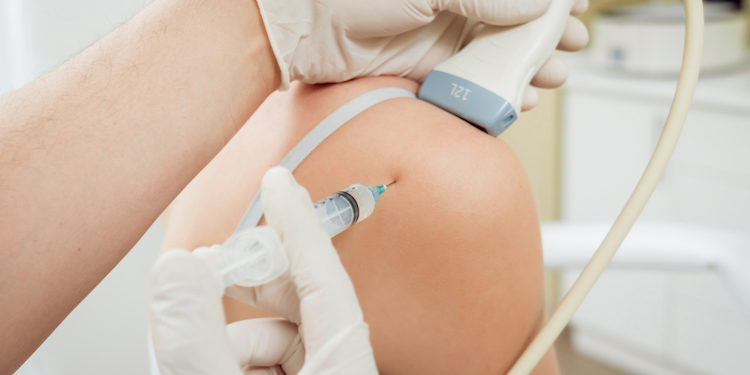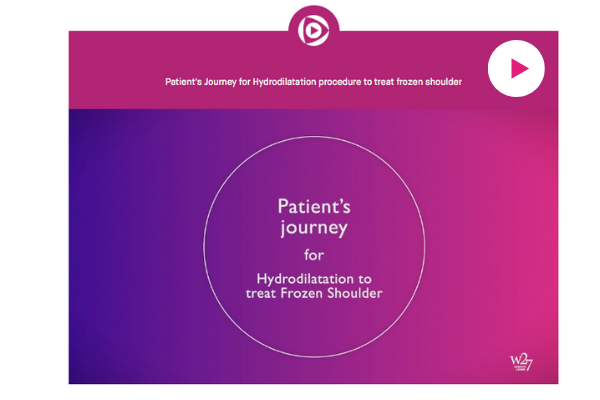A frozen shoulder can be extremely painful. It is caused by inflammation of the joint lining and/or restricted movement due to the formation of scar tissue. Read our mini-guide to shoulder Hydrodilatations, a treatment that can help ease the pain of a frozen shoulder.
What is a Frozen Shoulder?
The clinical term for the condition is Adhesive Capsulitis. It can last between one and a half to five years and it can cause chronic pain and a deterioration to the quality of life.
Causes
It is not entirely clear what causes a frozen shoulder. In some cases it is due to injury or surgery that prevents you from moving your arm normally. People with diabetes can also develop the condition although it is unclear why.
Hydrodilatation Injection
Hydrodilatation is a therapeutic injection that has been found to be very effective at relieving the pain of frozen shoulder. It is a quick outpatient procedure that is used alongside physiotherapy to restore movement to the shoulder and reduce inflammation.
It involves injecting steroid and local anaesthetic into the affected area to relieve pain and reduce inflammation. Saline solution is also injected into the joint lining to help to stretch it from the inside and weaken or break down scar tissue.
Benefits
Around 90% of people experience a reduction in pain and 70% benefit from increased movement after hydrodilatations.
In some cases the improvement is immediate but for many people it can take a few weeks for it to take effect.
You will be given a follow-up appointment with a physiotherapist a few days after the procedure to monitor your progress.
Risks
The risks are very small but there is a small risk you may develop an infection which will normally be treated with antibiotics and by washing out the joint. In rare cases you may be allergic to the steroid which can cause a rash that may last for a week.
What to expect
The procedure takes around 25 minutes and is carried out in a specialist clinic or hospital outpatients. You should take your normal pain relief medication before your appointment and tell the radiologist if you are taking any blood-thinning medication.
During the procedure you may experience a feeling of pressure due to the stretching of the shoulder lining and some pain but this should ease quickly after the procedure.
Here is an animation video showing you what you can expect during a Hydrodilatation procedure
At the appointment
The radiologist will explain what will happen and give you a consent form to sign. An X-ray or ultrasound will be used to guide the injection into the right place. After cleaning your skin with a sterile solution, you will be given an injection of local anaesthetic. Once the area is completely numb we will carefully insert a needle into the affected joint. You may feel a slight pushing sensation.
The syringe is removed, leaving the needle in the joint. We will then attach a three-way connecting tube to the needle. Firstly we will inject a dye solution into your joint so that we can see on the X-ray that the needle is correctly located. You may feel some tightness or heaviness in your joint but this should quickly pass.
Next we will inject a mix of steroid and local anaesthetic and a solution of saline. Between 30-35ml of fluid will be injected into the joint causing a feeling of tightness or pressure. Once the procedure is complete, the syringes and needle will be removed and a plaster applied over the wound. You will need to keep the area clean and dry for several hours.
After the appointment
Afterwards your shoulder joint may feel heavy or numb but this should wear off quickly. You will be able to go home 15-30 minutes after the procedure but you should not drive yourself. Any numbness will wear off after a few hours and should be completely gone by the following day.
Continue using your joint as normal to prevent stiffness but do not participate in heavy exercise or put excessive strain on the injected shoulder for 24-48 hours. Once the anaesthetic has worn off you may experience a temporary increase in pain but this should improve. It is important to continue with physiotherapy to support your recovery.
Next steps
If you have been suffering with a frozen shoulder or have persistent undiagnosed shoulder pain, contact our team to discuss a diagnostic test as soon as possible so you can find out the true cause of your pain and start to take the right steps back to good health.










